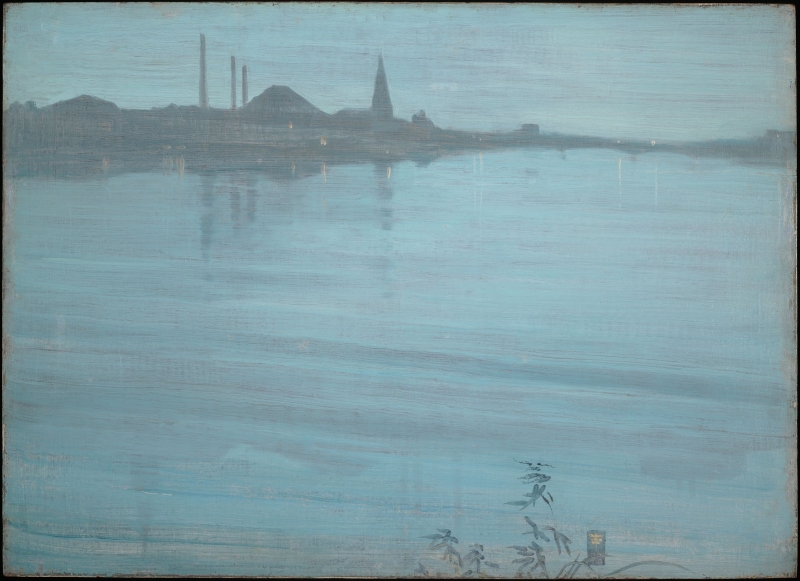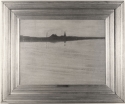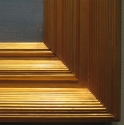Composition
Pentimenti of three inverted chimneys and a spire, upside down at lower left, suggest that Whistler originally began the picture with the canvas the other way up.
Technique
According to Whistler, speaking at the time of the Whistler v. Ruskin trial in 1878, he 'completed the mass of the picture in one day.' 1 The New York Semi-Weekly Tribune reported Whistler as saying 'he began and completed [it] in a day, after having arranged the thing in his mind.' 2
It is thinly painted on a cradled wooden panel. The Harvard website comments, 'With its muted, blue-gray tones and diluted paints, Nocturne in Blue and Silver exemplifies the artist’s radically reductive style.' 3
On the water and sky, the brushstrokes sweep from left to right, across the width of the canvas. The factory chimneys were painted over the sky, but the silhouettes of the factories and warehouses on the horizon were redefined in places. The leaves in the foreground were painted with very thin, almost translucent strokes of a pointed brush.
An illuminating exhibition and catalogue by Marc Simpson explored the technical skills used by Whistler to paint his Nocturnes, with this Nocturne cited as an example of the artist's early style, when the brushstrokes are clearly visible, compared to the extremely soft, blurred surfaces of a later Nocturne in Blue and Silver [YMSM 151]. 4
Conservation History
Photographs suggest the painting has not suffered any serious damage or deterioration.
Frame
By 1872: the painting probably had a frame similar to that on Nocturne: Blue and Silver - Chelsea [YMSM 103] decorated with the painted seigaiha.
1878: At the Grosvenor Gallery, the art critic of the Morning Post wondered whether the titles of paintings referred to the frames: 'The fancy subjects are equally puzzling. What is meant by a Nocturne in black and gold? (4), and what by a Nocturne in blue and silver? (5). One of these things has a silver frame, the other a gold one.' 5
According to Frances Leyland (1834-1910), quoted by Elizabeth Robins Pennell (1855-1936), on 26 October 1903:
'It was her nocturne that was brought into court in the place of Mrs. Wyndham’s, which she insists was the one Ruskin wrote about. Mrs. Wyndham was away, and hers was sent down from Speke Hall, and she was furious because it was taken into court without the frame, and the frame was painted by Whistler – with blue waves, carrying out and completing the design. It got so battered afterwards she had it gilded over.' 6
This suggests that the original frame was re-gilded some time after 1878.
1892: The painting probably received a new frame made by Frederick Henry Grau (1859-1892) during preparations for the Goupil Gallery exhibition, when Whistler instructed the manager, D. C. Thomson:
‘Mrs Leyland – Get her Nocturne so that no time may be lost – for cleaning varnishing & framing. My man Grau to frame & glaze it without referring the matter to Mrs L - Indeed in several cases I shall have frames made on my own account - taking them off afterwards.’ 7
Thus Mrs Leyland’s picture was probably reframed in a reeded Grau frame, but it is not known if the original frame was replaced following the exhibition.
1910-1930: It is not known how the painting was framed after Mrs Leyland's death, when it went into American collections.
ca 1930: It is currently surrounded by a Grau-style frame made by M. Grieve of New York City about 1930, which bears the label of the Grieve Company. [FD] 25 ½ x 32 (64.7 x 81.2), [MW] 4 ¼ (10.8).
Grenville Lindell Winthrop (1864-1943) bequeathed his Whistlers to the Fogg Art Museum in 1943. It appears that in preparation for his bequest, or following their accession to the museum, these paintings were given identical replica Grieve-made frames.
Notes:
1: Whistler 1890 [more] , p. 8. Merrill 1992 [more] , pp. 151-52.
2: Press cutting in GUL Whistler PC 2, p. 27.
3: See X-radiograph on Harvard Art Museums website at https://www.harvardartmuseums.org.
4: Simpson, Marc, Like Breath on Glass: Whistler, Inness, and the Art of Painting Softly, Sterling and Francine Clark Art Institute, Williamstown, MA, 2008, pp. 4, 8-9, repr. p. 5.
5: 'The Grosvenor Gallery, Morning Post, 1 May 1877, p. 6.
Last updated: 13th May 2021 by Margaret










